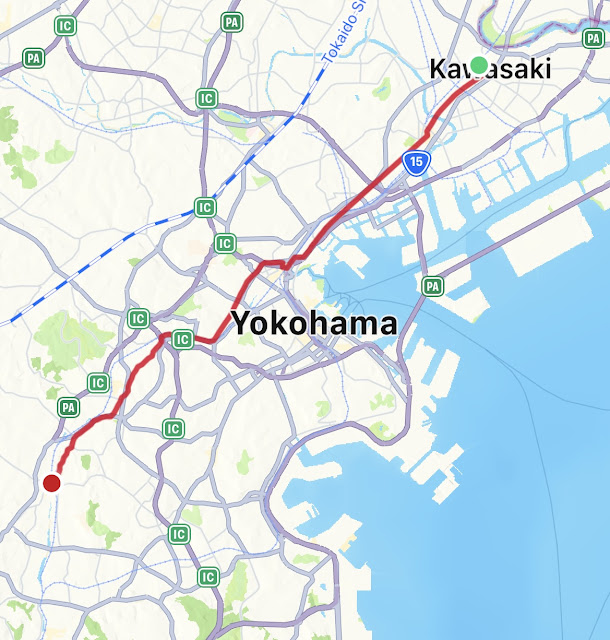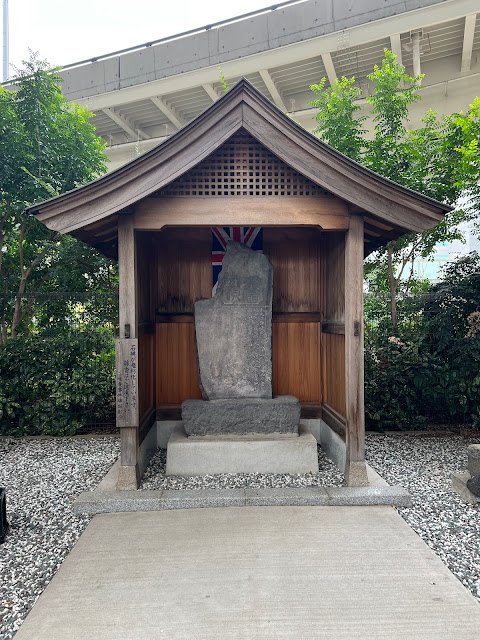Light rain punctuated the day. For much of the time it was more of a nuisance to hold the umbrella than to get slightly damp, but although humid it was reasonably cool and pleasant walking conditions.
Like the previous day, today was short on scenic beauty but long on immersion in the ‘real’ Japan of shops and houses and schools and workplaces. And people.
To get back to Kawasaki from Odawara involved three trains, including a 15-minute blast on the Shinkansen to Ofuna. From Kawasaki station entrance I picked up the Old Tokaido route, and after a couple of kilometres at Hatcho-nawate came across this roadside memorial.
A nearby plaque said it was to honour people whose remains had been unearthed in the area, suggesting they had been victims of natural disasters such as “earthquakes, large fires, floods, famine and epidemics”.
A little further on was the day’s first shrine, a very small one set on a mound that had once been an ichi-ri-zuka or ‘one-ri-mound’. A ri was a unit of measurement along the Tokaido, supposedly the distance someone could walk in an hour – about four kilometres.
I paid my respects, and as I was organising my backpack noticed a woman who had arrived at the bus stop next to the shrine. We nodded in greeting, and she said something that I think was asking if I was waiting for the bus. I did my best to say that I was walking, and she apparently decided she would walk with me.
And so we walked together for a couple of kilometres, as far as Tsurumi, where I think she told me she was catching a train to visit a friend.
Our conversation was painfully limited by my lack of Japanese, but here’s what I think she told me:
– She asked me how old I was, and I think I did a reasonably good job of telling her. In return, I think she told me she was 67.
– I asked if she had any children, and she told me she had five. (That seems large for a Japanese family, so there may have been grandchildren involved in that calculation.) I told her I had two sons and one daughter.
– I showed her the explanatory note Kumi had helped me write, but she still seemed surprised when we reached Tsurumi and I explained that rather than catching the train I would continue walking.
– I asked her name, and I think she said Kase, but that doesn’t look right. In the unlikely event she ever reads this, I do apologise for not asking her to write it in hiragana for me.
She said a lot more along the way, but I understood very little.
At Tsurumi station we parted ways and I asked if I could take her photograph. She was embarrassed, but generous enough to agree.
 |
At Tennocho station, a small park contains a wooden ‘bridge’ over nothing, another nod to the past. |
And on I walked. The drizzle fell and the light started fading. High school kids made their way home and commuters waited at bus stops. A konbini offered bathrooms and a chance to purchase snacks for later.
Eventually I reached Totsuka and collapsed on a bus stop bench outside the station, from where a couple of thankfully very uncrowded trains took me back to Odawara.
This was, I think, one of the longer days I’ll have on this trek. Although largely flat, there was a significant climb towards the end and – at least equally challenging for the legs – a significant descent on the other side. I’m not sure if it’s a good sign that I’m starting to look forward to my first rest day already.









Nice to make a friend today! 🥰
ReplyDeleteThanks Gen. She was so friendly, and I just wish we could have had a proper conversation. I made more friends today, but I’m too tired now to write anything worthwhile, so I’ll post about it in the morning.
ReplyDelete